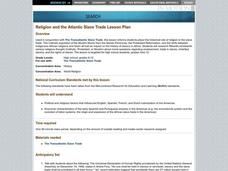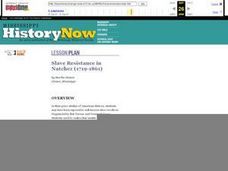College Board
2010 AP® English Language and Composition Free-Response Questions
Humorists do more than tell jokes; they also impart key messages about society. A series of free-response topics from the AP® English Language and Composition exam cover three topics, including one discussing the role of humorists....
College Board
2002 AP® English Language and Composition Free-Response Questions
It is not what you say but how you say it. Scholars use an essay prompt from the 2002 AP® English Language and Composition Free-Response Questions to analyze how an author uses language to describe her past. They also support or argue a...
Literacy Design Collaborative
Rhetorical Analysis of Frederick Douglass
Is the Fourth of July a celebration for all Americans? Scholars carry out a close read of What to the Slave is the Fourth of July? Readers talk with partners about the speaker's point of view, the author's debate, reasoning, and...
EngageNY
Grade 11 ELA Module 2: Unit 1, Lesson 8
Was freedom really free? Scholars analyze paragraphs six and seven of Du Bois's chapter "Of Our Spiritual Strivings." They look at how the author uses rhetoric to strengthen his point of view about freedom. Learners complete a Rhetorical...
EngageNY
Comparing Multiple Accounts of the Same Topic: The Story of Bus Desegregation (Promises to Keep, Page 21)
It's all connected. Learners read event details in Promises to Keep to determine the connection between the bus boycott and Jackie Robinson. They watch a video and read Rules for Riding Desegregated Buses to discover even more details to...
Curated OER
RELIGION AND THE ATLANTIC SLAVE TRADE
Students examine the political and religious factors that influenced English, Spanish, French, and Dutch colonization of the Americas, and the economic characteristics of the early Spanish and Portuguese empires in the Americas.
Curated OER
How Far to Freedom?
Young scholars research the life of William Parker to learn about the Underground Railroad. In this US history lesson, students research William Parker and the Underground Railroad. Young scholars research the Christiana Resistance and...
Curated OER
Declaration of Independence: Created Equal?
Students examine how Jefferson dealt with equality. In this lesson on the Declaration of Independence, students use primary sources to analyze what the phrase, "All men are created equal" meant. They will compare what they think equality...
Curated OER
Migration and Political Power Lesson Plan: A Mapping and Graphing Activity
Middle schoolers examine how the end of slavery and the diffusion of African Americans across the United States contributed to its political successes following the civil rights era. In groups, they use information from a narrative to...
Curated OER
How Was the Inside vs. Outside Paradigm Created?
Students, after listening to a lecture, examine Nigeria from slave trading to the Civil War as well as listen to the Arrested Development song about slavery. In addition, they create a circle diagram for essay #1.
Curated OER
All Aboard: Underground Railroad Knowledge Chart
Fifth graders research the Underground Railroad. In this Underground Railroad lesson, 5th graders start a KWL chart about the Underground Railroad. Students use a map to locate slavery areas and free states. Students view a PowerPoint...
Curated OER
An Abolitionist Lecture
Tenth graders investigate the Abolitionist Movement in the United States. For this 19th century American lesson, 10th graders research Frederick Douglas, William Lloyd Garrison, and Sojourner Truth and their efforts to end slavery....
Curated OER
Slave Code Songs
Seventh graders study water bodies that were escape routes to Canada for slaves seeking freedom. They examine and create a coded spiritual that describes a personal experience with secrecy and fear.
Curated OER
National and Regional Identity
Learners examine state quarters to identify symbols that represent national and regional identity. They discuss the process used to determine what is put on the quarter. They review colonial money, and euros to look for cultural images.
Curated OER
Backward Lesson Plan
High schoolers explore and analyze the position of freedmen in the post Civil War period as well as the impact of Andrew Johnson's presidency on Reconstruction. In addition, they evaluate the laws and amendments that were put in place...
Curated OER
Plantation Economy Discussion: Activity 6
Lead your class in a discussion on the many components of plantation economics during the colonial period. This presentation is comprised of a single slide which houses 13 discussion topics related to plantation economy. Note: Use this...
National Endowment for the Humanities
The Question of Representation at the 1787 Convention
While the Constitution is considered enshrined today, its current form is the result of haggling at a secret convention in 1787. Using transcripts from the meetings and various plans as drafted by the delegates, class members unpack the...
Curated OER
Mapping the Many Underground Railroads
Students determine the beginning and the end points of the enslaved person's journey to freedom, noting landmarks mentioned along the way such as cities, towns, rivers, mountains, and other geographic features.
Curated OER
Slave Resistance in Natchez
Students examine various ways that slaves in the Natchez area resisted bondage, consider the price of resistance, and write television news documentary.
Curated OER
Slave Narratives
Students examine many different slave narratives living in the 1700s. In groups, they identify and describe the major events in their lives and arrange them into chronological order. They use this information to create a timeline and...
Curated OER
Slave Narratives
Students use a database to find and read examples of slave narratives. In groups, they read the various narratives and discuss their feelings about them. They also research the time period in which the narratives were written to end...
Curated OER
In The Footprints of the Slaves and Conductors
Fifth graders research and examine the conductor sites to find routes to hide their slaves. They are given a map to map out a route to hide fifteen slaves. Each group is given three to four clues about their stations to pass on to...
Curated OER
Runaway Ad - Using Primary Documents
Young scholars examine a runaway slave advertisement. For this American history lesson, students investigate a missing slave advertisement run by Thomas Jefferson in 1769. Young scholars make inferences based on the advertisement.
Curated OER
Early Colonial Labor Force: Indentured Servants and Slaves
Students study the labor force used during Colonial America. In this Colonial America lesson, students discuss labor types used in the colonies. Students read about indentured servants and the use of African slaves. Students use the...
Other popular searches
- Up From Slavery
- Civil War Slavery
- Abraham Lincoln and Slavery
- Slavery Art
- Abolition of Slavery
- American Slavery
- Anti Slavery Poetry
- African American Slavery
- Slavery Issue
- Controversy Over Slavery
- Escaping From Slavery
- Constitution: Slavery

























